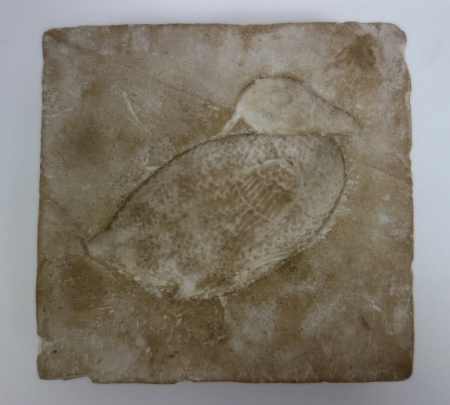Online Collections at UoB - Objects
ID number: ECM 1063
Named collection: The Eton Myers Collection
Title / Object name: Limestone Mould of Bird
Object type: Mould
Culture: Egyptian
Date made: Late Period (ca. 664-332 BCE)
Collector: Myers, William Joseph
Materials: Limestone
Measurements: overall: 1.60 cm x 8.60 cm x 8.30 cm (H x W x D)
Provenance: Unknown
|

|
Limestone mould for a wax benu bird. The head, with a rear tuft, is shown close to the body and its leg is drawn up in the usual manner. The body is decorated with longitudinal rows of simple 'rocker' engraving. The edges of the back of the mould are bevelled and is inscribed with a single line of faded demotic or arabic.
Bibliography: For more information about the use of beeswax in ancient Egypt, see
Z. Shoosmith 2016 'Life Through Wax: Beeswax in ancient Egypt' in S. Boonstra (ed.) Objects Come to Life Virtual Exhibition, Birmingham Egyptology.
Notes: This type of mould would have been used to cast a beeswax benu bird. Limestone is a soft stone that is relatively easy to carve, and often used as a sculptural base. Some Egyptian traditions express the belief that the benu bird had existed in the void before creation (Nun) and that its call began the formation of the world. Consequently in ancient Egypt, the benu bird was associated with creation. Benu bird models could be placed in tombs to represent a rebirth for the deceased. In the Late Period, these models were, in some cases, replaced by moulds such as this one.
Beeswax in ancient Egypt was associated with life. It was easy to sculpt, allowing an individual to mimic the god Khnum, who made life on a potter's wheel. Beeswax was also associated with the solar god Re whose tears were said to have turned into the first bees. The life-giving symbolism of beeswax made it useful to help the dead into the afterlife. Amulets such as scarabs and ankhs were sometimes made of wax. Mummy portraits could also be given life-like textures with beeswax and metal sculptures could be made more detailed through 'lost wax casting'. Models made with wax could be used when vitality was needed either to help or harm a person. Destroying a model enemy was seen to destroy the threat of an actual enemy. A wax model could also encourage healing or aid rebirth into the afterlife. Consequently wax models could be used in a wide range of circumstances and were common in Egyptian society.
|
2 Related Media Items
| << Viewing Record 8 of 20 >> |